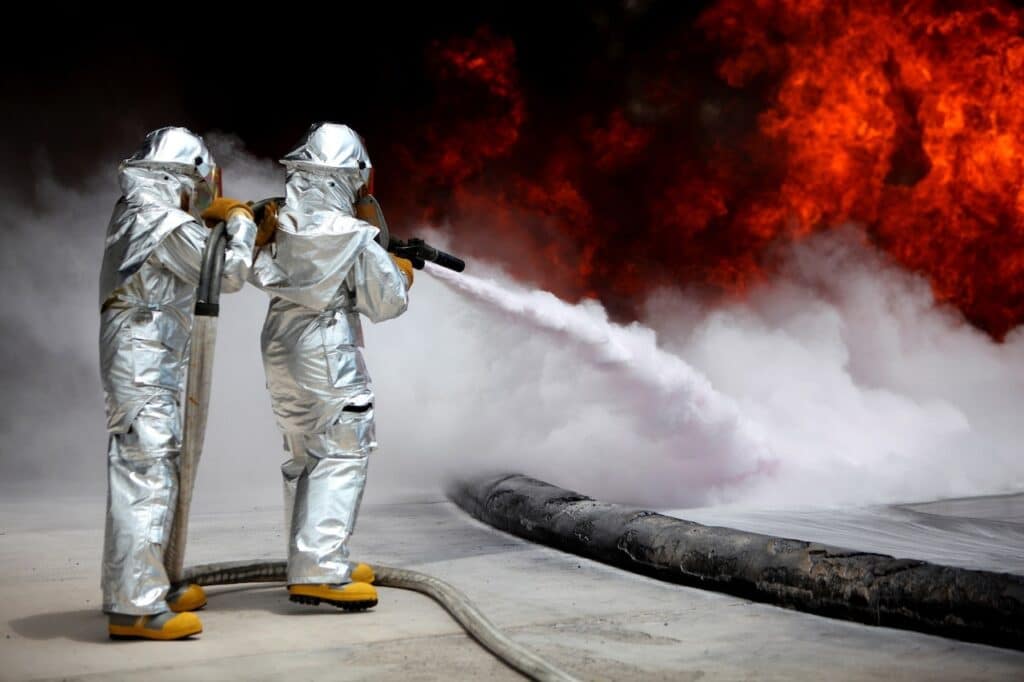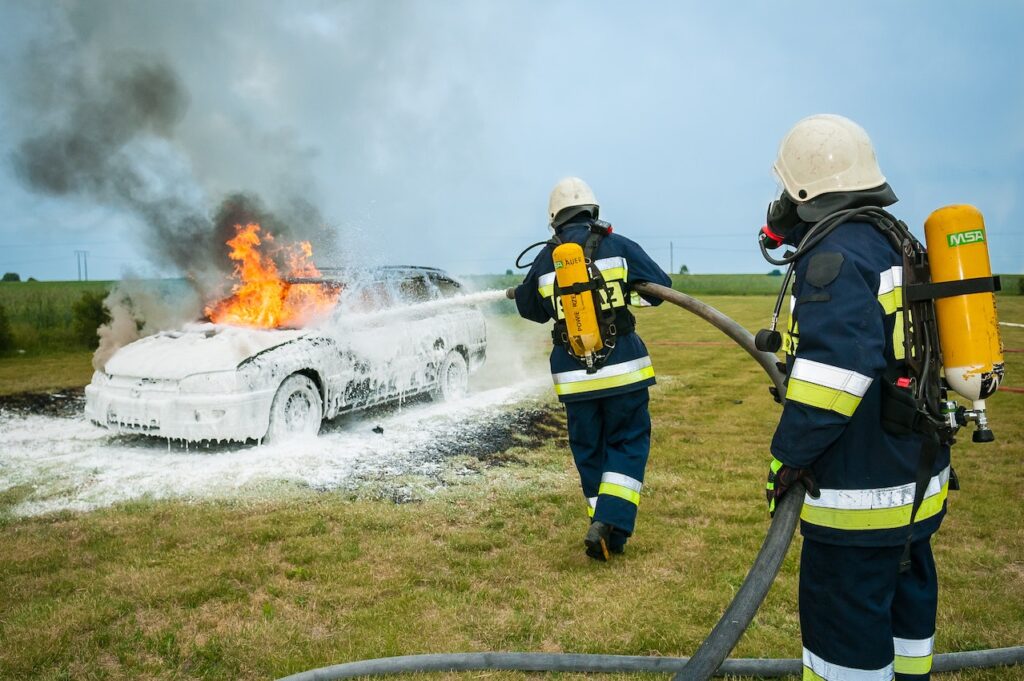Aqueous Film Forming Foam, often shortened to AFFF, is a foam concentrate used to put out flammable liquid fires. It’s commonly used in firefighter training centers, ships, military bases, as well as the average household fire extinguisher. However, some types of AFFF contain toxic chemicals, which can pose a serious health risk. For instance, studies have found that exposure to these chemicals could potentially increase the risk of developing cancer.
What is AFFF?
AFFF, or Aqueous Film Forming Foam, is made up of water and other chemicals like ethylene and propylene glycol, which help the foam last longer. It is considered a class B foam. Firefighters use this foam, which comes in a concentrated form that gets mixed with water, to put out fires. You can find AFFF in different strengths, such as three percent and six percent, depending on how much water is added.
AFFF firefighting foam is mainly used to put out fires that are hard to control with water, especially fires caused by flammable liquids like petroleum.
To make the foam concentrate and create a “foam blanket” that can extinguish fires, AFFF contains chemicals known as per- and polyfluoroalkyl substances, or PFAS. These have been used in many consumer and industrial products since the 1950s.
Two common types of PFAS chemicals you can find in AFFF are perfluorooctane sulfonate (PFOS) and perfluorooctanoic acid (PFOA). These are man-made chemicals that don’t naturally occur in the environment.
Firefighters use AFFF by spraying it onto a fire. It works by covering the fuel that’s feeding the fire and cooling it down. It also forms a film over the fuel fire, which stops oxygen from getting to it. This prevents the fire from reigniting.

The Dangers of AFFF Foam
Aqueous Film Forming Foam can be harmful, especially if it includes chemicals called PFOA and PFOS.
According to the U.S. Department of Veterans Affairs and the Environmental Protection Agency (EPA), small amounts of these chemicals can be found in the blood of most people in the United States. For most people, these tiny amounts aren’t a problem.
However, the U.S. Fire Administration says that long-term exposure to these chemicals can be harmful. These chemicals can build up in the body over time, and may lead to health issues, including cancer.
Studies conducted in labs have found that PFOS and PFOA can be toxic to animals. The EPA has also found evidence suggesting that these toxic chemicals might cause cancer in humans.
Due to these health and environmental concerns, some manufacturers agreed to stop producing PFOS in the U.S. beginning in 2002. Other companies also agreed to stop producing PFOA and related chemicals by 2015, as per the EPA.
In January 2021, the EPA issued a final rule, known as the Significant New Use Rule (SNUR), to regulate PFAS. This rule means that companies have to get approval from the EPA before they can import, manufacture, use, or process certain long-chain PFAS. This rule also applies to companies importing the chemical for use as a surface coating.
However, despite these regulations by the EPA, there may still be old reserves of AFFF product that still contain the chemical.
Fact: The International Agency for Research on Cancer (IARC) has labeled PFOA as a 2B carcinogen. This means that it’s potentially cancer-causing in humans.
AFFF Exposure Health Problems
Several studies have identified potential health problems related to the chemicals found in Aqueous Film Forming Foam. However, more research and medical evidence are needed to fully understand the risks these chemicals pose to human health.
Not everyone who is exposed to the PFAS chemicals in AFFF, will get sick. Whether or not someone develops health problems depends on factors like how often they’re exposed, how much they’re exposed to, and how long they’ve been exposed. People with long-term exposure are generally at a higher risk.
Researchers, along with organizations like the Environmental Protection Agency and the U.S. Department of Veteran’s Affairs, have linked the PFAS containing foam to a variety of health issues. These include:
- Asthma
- Cholesterol issues
- Developmental changes in infants and children
- Fertility problems
- Immune system changes
- Increased risk of caners, like kidney and testicular cancer
- Liver damage
- Preeclampsia
- Thyroid disease
- Ulcerative colitis/inflammatory bowel disease.

Exposure Risks
Large companies, like 3M, make Aqueous Film Forming Foam. Firefighters and military personnel have been using PFAS containing foam for many years.
People who work closely with this toxic firefighting foam, such as current and former civilian or military firefighters, may face a risk of long-term exposure and possible health problems.
Additionally, these chemicals can seep into the environment and drinking water supply. So, people living near places that use AFFF, like military bases or chemical plants, could also be at risk.
According to the Environmental Protection Agency, people who work with these chemicals—or live near facilities that use a PFAS substance tend—to have higher levels of these chemicals in their blood.
AFFF is used in a variety of places, such as:
- Chemical plant
- Fire department
- Military base
- Highway emergency response teams
- Aircraft facilities
- Places that process and store flammable liquids
- Oil tankers and offshore drilling rigs
- Petroleum refineries and large oil storage facilities
Fact: The Department of Defense started using AFFF to put out fuel fires at military bases back in the 1970s. Unfortunately, this has led to a significant amount of PFAS water contamination in the communities located near these bases.
AFFF Lawsuit
People who have been exposed to high levels of Aqueous Film Forming Foam subsequently developed serious health conditions, like cancer, are taking legal action. They’re filing an AFFF lawsuit against the manufacturers of these products, including big companies like 3M.
Some of the first to file these personal injury lawsuits have been military and civilian firefighters who were diagnosed with cancer and other health conditions. Many of these firefighters had been using AFFF for several years.
The foam lawsuit alleges that the companies that produced the foam knew or should have known about the risks. They argue that PFAS exposure is toxic, and that this hazardous substance can build up in the human body and lead to a wide range of health problems. Despite knowing these risks, the companies failed to warn the public that AFFF/PFAS exposure could be harmful to public health.
References
- https://dec.alaska.gov/spar/csp/pfas/firefighting-foam/
- https://monographs.iarc.who.int/list-of-classifications
- https://theintercept.com/2018/02/10/firefighting-foam-afff-pfos-pfoa-epa/
- https://www.epa.gov/sites/production/files/2017-12/documents/ffrrofactsheet_contaminants_pfos_pfoa_11-20-17_508_0.pdf
- https://www.epa.gov/sites/production/files/2021-01/documents/final_lcpfac-snur_surface-coating-compliance-guide_0.pdf
- https://www.nist.gov/system/files/documents/el/fire_research/R0201327.pdf
- https://www.publichealth.va.gov/exposures/pfas.asp
- https://web.archive.org/web/20210318080826/https://www.epa.gov/sites/production/files/2021-01/documents/final_lcpfac-snur_surface-coating-compliance-guide_0.pdf
